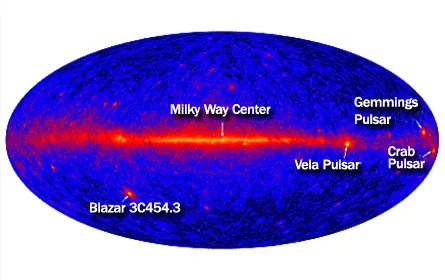- More than 2 years ago
Normal 0 false false false MicrosoftInternetExplorer4 NASA’s GLAST spacecraft has successfully snagged its first gamma rays — and been given a proper name.
After just 95 hours of data collection, the craft’s mission scientists were able to produce GLAST’s first all-sky map of gamma rays in the universe. It took GLAST’s predecessor an entire year to do what the new craft has done in about four days, said Peter Michelson, principal investigator for the LAT, one of two GLAST instruments, in an August 26 NASA press briefing.

GLAST, the Gamma-ray Large Area Space Telescope, is an Earth-orbiting satellite that studies the universe’s highest-energy form of electromagnetic radiation — gamma rays. The spacecraft uses two specialized instruments: the Large Area Telescope, LAT, and the GLAST Burst Monitor, GBM.
In orbit only since June 11, the LAT has already detected two extraordinarily bright, flaring gamma-ray sources. Those sources are probably blazars, energy-emitting regions powered by supermassive black holes at the cores of active galaxies, said Michelson, of StanfordUniversity.
Every three hours the LAT scans the sky for gamma rays. When the LAT was turned on, 3C 454.3, a blazar 7.1 billion light-years from Earth in the constellation Pegasus, was “so bright it was impossible to miss,” said GLAST project scientist Steven Ritz of NASA’s Goddard Space Flight Center in Greenbelt, Md. Monitoring gamma rays from such sources and others will give astrophysicists clues to the physics causing these flares, he said.
“We are observing the gamma ray sky every day, many times,” Michelson said. “This is like watching the night sky at a Fourth of July celebration, but we are seeing it on a cosmic scale.”
The GLAST Burst Monitor also had its share of success in its first month of operation, said Charles Meegan, GLAST Burst Monitor principal investigator at NASA’s MarshallSpaceFlightCenter in Huntsville, Ala. The GBM registered 31 short-lived spurts of gamma rays and detects roughly one burst per day, he said.
GLAST is no longer GLAST, noted Jon Morse, the astrophysics division director at NASA headquarters in Washington, D.C. The space observatory is now officially known as the Fermi Gamma-ray Space Telescope — a tribute to legendary physicist Enrico Fermi’s pioneering work on quantum physics and the first nuclear reactor, Morse said.
With the Fermi satellite, scientists will now be able to answer questions about supermassive black hole systems, pulsars and cosmic rays and to search for “signals of the mysterious dark matter and even exotic, previously unknown laws of physics,” Morse added.







